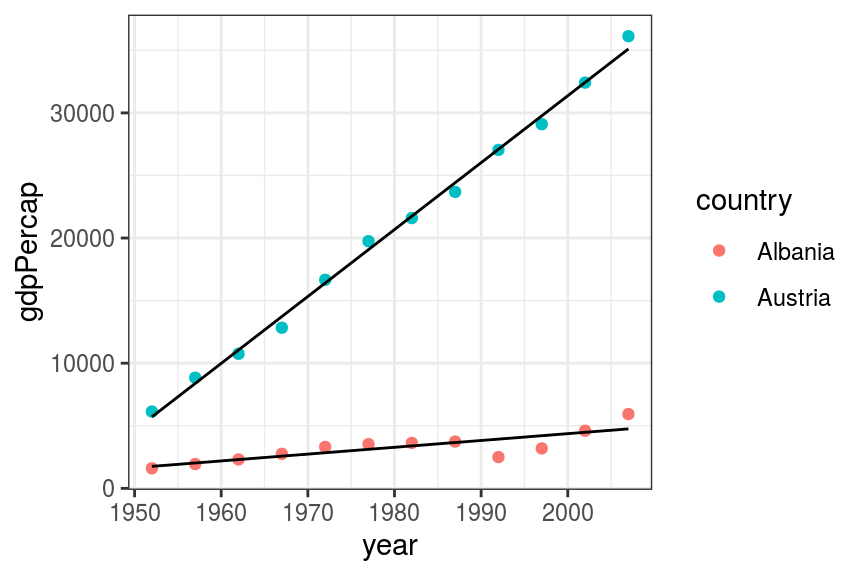7.5 Solutions
Solution to Exercise 7.4.2:
gapdata %>%
filter(continent == "Europe") %>%
ggplot(aes(x = year, y = gdpPercap)) +
geom_point() +
geom_smooth(method = "lm") +
facet_wrap(country ~ .)## `geom_smooth()` using formula 'y ~ x'
# Countries not linear: Ireland, Montenegro, Serbia.
# Add quadratic term
gapdata %>%
filter(continent == "Europe") %>%
ggplot(aes(x = year, y = gdpPercap)) +
geom_point() +
geom_smooth(method = "lm", formula = "y ~ poly(x, 2)") +
facet_wrap(country ~ .)
Solution to Exercise 7.4.3:
# Plot first
gapdata %>%
filter(country %in% c("Albania", "Austria")) %>%
ggplot() +
geom_point(aes(x = year, y = gdpPercap, colour= country))
# Fit average line between two countries.
fit_both1 = gapdata %>%
filter(country %in% c("Albania", "Austria")) %>%
lm(gdpPercap ~ year, data = .)
gapdata %>%
filter(country %in% c("Albania", "Austria")) %>%
ggplot() +
geom_point(aes(x = year, y = gdpPercap, colour = country)) +
geom_line(aes(x = year, y = predict(fit_both1)))
# Fit average line between two countries.
fit_both3 = gapdata %>%
filter(country %in% c("Albania", "Austria")) %>%
lm(gdpPercap ~ year * country, data = .)
gapdata %>%
filter(country %in% c("Albania", "Austria")) %>%
ggplot() +
geom_point(aes(x = year, y = gdpPercap, colour = country)) +
geom_line(aes(x = year, y = predict(fit_both3), group = country))
# You can use the regression equation by hand to work out the difference
summary(fit_both3)
# Or pass newdata to predict to estimate the two points of interest
gdp_1980 <- predict(fit_both3, newdata = data.frame(
country = c("Albania", "Austria"),
year = c(1980, 1980))
)
gdp_1980
gdp_1980[2] - gdp_1980[1]Solution to Exercise 7.4.4:
# Plot data first
wcgsdata %>%
ggplot(aes(x = age, y = chol))+
geom_point() +
geom_smooth(method = "lm", formula = "y~x")## Warning: Removed 12 rows containing non-finite values (stat_smooth).## Warning: Removed 12 rows containing missing values (geom_point).
# Weak positive relationship
# Simple linear regression
dependent <- "chol"
explanatory <- "age"
wcgsdata %>%
finalfit(dependent, explanatory, metrics = TRUE)## Note: dependent includes missing data. These are dropped.# For each year of age, cholesterol increases by 0.7 mg/100 ml.
# This gradient differs from zero.
# Is this effect independent of other available variables?
# Make BMI as above
dependent <- "chol"
explanatory <- c( "age", "bmi", "sbp", "smoking", "personality_2L")
wcgsdata %>%
mutate(
bmi = ((weight*0.4536) / (height*0.0254)^2) %>%
ff_label("BMI")
) %>%
finalfit(dependent, explanatory, metrics = TRUE)## Note: dependent includes missing data. These are dropped.